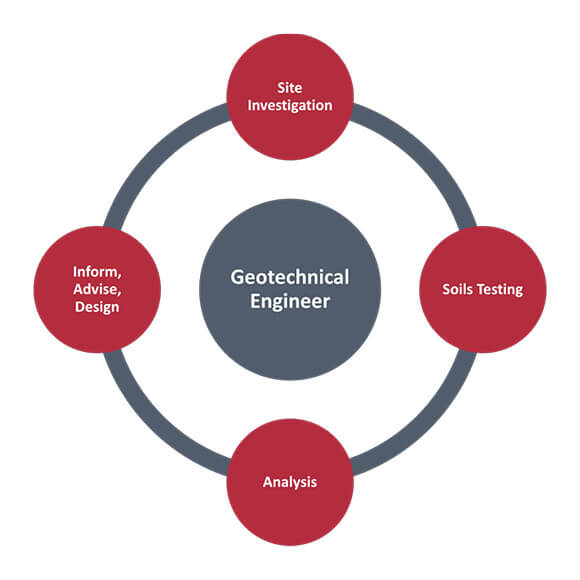Some Known Details About Geotechnical Engineering For Construction Projects
Some Known Details About Geotechnical Engineering For Construction Projects
Blog Article
Fascination About Geotechnical Engineering For Construction Projects
Table of ContentsThe smart Trick of Geotechnical Engineering For Construction Projects That Nobody is Talking AboutGeotechnical Engineering For Construction Projects Fundamentals ExplainedGeotechnical Engineering For Construction Projects Things To Know Before You BuyNot known Incorrect Statements About Geotechnical Engineering For Construction Projects The Definitive Guide for Geotechnical Engineering For Construction Projects5 Simple Techniques For Geotechnical Engineering For Construction Projects
These attributes need to be analyzed by geotechnical engineers to forecast their movements under different scenarios., making this analysis essential.A geotechnical designer will certainly examine soil to establish the bearing capacity of the earth and advise correct foundation types, such as superficial foundations, deep foundations like stacks, or specialized solutions like floating foundations for soft dirts. Understanding the functions and actions of soil and rock, in enhancement to exactly how they communicate with building and constructions that have been put up on or within them, is just one of the main descriptions for why geotechnical design is essential.
Ecological protection is achieved via geotechnical engineering. Know-how in air, water, and dirt high quality upkeep is placed to utilize by geotechnical engineers to reduce the unfavorable results of jobs.
To sum up, geotechnical design is a vital discipline that preserves the strength and integrity of civil facilities. Geotechnical designers add to making structure tasks reliable all over the world by understanding the behavior of earth materials and applying appropriate preparation methods.
Getting The Geotechnical Engineering For Construction Projects To Work
The fundamental stability of any kind of task is crucial. Geotechnical design plays a critical duty in guaranteeing that structures are improved solid ground, essentially and figuratively. By taking a look at soil, rock, and subsurface conditions, geotechnical designers provide crucial insights that aid in the style, building and construction, and maintenance of buildings and infrastructure.

Some Known Details About Geotechnical Engineering For Construction Projects
Laboratory screening: Identifying the residential or commercial properties of soil and rock. Area screening: Carrying out examinations on-site to examine problems. Analysis and layout: Making use of data to develop foundations, retaining wall surfaces, tunnels, and various other structures. Several high-profile building tasks have actually successfully made use of geotechnical engineering to guarantee their stability and safety and security. :: The globe's highest structure needed a deep understanding of the underlying geology.
As a leader in geotechnical engineering, BECC Inc. is dedicated to supplying cutting-edge and efficient options that meet the highest requirements of quality and security. For additional information on just how BECC Inc. can support your following building and construction job, call us today and let us help you construct on solid ground.
William Rankine, a designer and physicist, established an alternative to Coulomb's earth pressure concept. Albert Atterberg developed the clay consistency indices that are still used today for dirt category. In 1885, Osborne Reynolds acknowledged that shearing causes volumetric expansion of dense products and tightening of loosened granular materials. Modern geotechnical design is claimed to have begun in 1925 with the publication of Erdbaumechanik by Karl von Terzaghi, a mechanical designer and rock hound.
Unknown Facts About Geotechnical Engineering For Construction Projects
Terzaghi likewise developed the structure for theories of bearing capability of foundations, and the concept for prediction of the rate of settlement of clay layers due to consolidation. Afterwards, Maurice Biot totally established the three-dimensional dirt loan consolidation concept, extending the one-dimensional model formerly created by Terzaghi to extra general hypotheses and presenting the set of fundamental formulas of Poroelasticity.
Geotechnical engineers examine and determine the homes of subsurface problems and products.
Things about Geotechnical Engineering For Construction Projects
Still, they are often utilized to allow a rock hound or designer to be decreased right into the borehole for direct visual and manual evaluation of the dirt and rock stratigraphy. Various dirt samplers exist to meet the requirements of different design projects. The conventional penetration test, which makes use of a thick-walled split spoon sampler, is one of the most common method to link gather disrupted examples.

If the user interface in between the mass and the base of a slope has a complex geometry, incline stability analysis is challenging and numerical option approaches are required. Normally, the interface's exact geometry is unknown, and a simplified user interface geometry is thought. Finite slopes require three-dimensional models to be analyzed, so most inclines are assessed thinking that they are infinitely vast and can be represented by two-dimensional designs.
How Geotechnical Engineering For Construction Projects can Save You Time, Stress, and Money.
Developing the design based on a working theory of behavior anticipated under the most likely conditions. Selection of amounts to be observed as construction earnings and computing their anticipated worths based on the functioning theory under the most negative conditions.
Measurement of quantities and examination of real check out this site problems. It is unsuitable for jobs whose style can not be modified throughout building.
Report this page